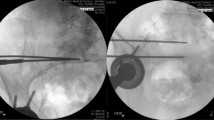Abstract
Purpose
Pelvis ring fractures of geriatric patients are currently a serious problem in orthopedic and trauma surgery. One controversy that remains is the insufficiency fracture of the sacrum with treatment options ranging from conservative to operative. We modified standard 7.3-mm screws with additional perforations at the tip to allow cement injection trough the screw to improve implant anchorage.
Method
We describe a new method of treatment of sacral insufficiency fractures. We use modified cannulated 7.3-mm screws (Synthes) with additional perforations at the screw tip. This allows the implant augmentation after proper implant positioning and contrast medium instillation for leakage detection.
Results
All patients (12 female) treated this way, are allowed to weight bear as tolerated immediately after surgery. The pain level (measured by the visual analog scale—VAS) was significantly reduced due to surgery (mean 8.2 pre-operatively, mean 2.6 postoperatively), the pain medication could be reduced rapidly.
Conclusion
The described procedure for the treatment of sacral insufficiency fractures has the potential to increase the safety of cement injection into the sacrum because of the possibility of contrast agent instillation prior to cement injection. Furthermore, the amount of cement can be reduced and additional stability can be attained due to iliosacral screw osteosynthesis compared to sacroplasty.

Similar content being viewed by others
References
Tosounidis G, Holstein JH, Culemann U, Holmenschlager F, Stuby F, Pohlemann T (2010) Changes in epidemiology and treatment of pelvic ring fractures in Germany: an analysis on data of German pelvic multicenter study groups I and III (DGU/AO). Acta Chir Orthop Traumatol Cech 77(6):450–456
Morris RO, Sonibare A, Green DJ, Masud T (2000) Closed pelvic fractures: characteristics and outcomes in older patients admitted to medical and geriatric wards. Postgrad Med J 76(900):646–650
Pohlemann T, Stengel D, Tosounidis G, Reilmann H, Stuby F, Stockle U, Seekamp A, Schmal H, Thannheimer A, Holmenschlager F, Gansslen A, Rommens PM, Fuchs T, Baumgartel F, Marintschev I, Krischak G, Wunder S, Tscherne H, Culemann U (2011) Survival trends and predictors of mortality in severe pelvic trauma: estimates from the German pelvic trauma registry initiative. Injury 42(10):997–1002. doi:10.1016/j.injury.2011.03.053
Lourie H (1982) Spontaneous osteoporotic fracture of the sacrum. An unrecognized syndrome of the elderly. JAMA 248(6):715–717
Frey ME, Depalma MJ, Cifu DX, Bhagia SM, Carne W, Daitch JS (2008) Percutaneous sacroplasty for osteoporotic sacral insufficiency fractures: a prospective, multicenter, observational pilot study. Spine J 8(2):367–373. doi:10.1016/j.spinee.2007.05.011
Fuchs T, Rottbeck U, Hofbauer V, Raschke M, Stange R (2011) Pelvic ring fractures in the elderly. Underestimated osteoporotic fracture. Unfallchirurg 114(8):663–670. doi:10.1007/s00113-011-2020-z
Tjardes T, Paffrath T, Baethis H, Shafizadeh S, Steinhausen E, Steinbuechel T, Rixen D, Bouillon B (2008) Computer assisted percutaneous placement of augmented iliosacral screws: a reasonable alternative to sacroplasty. Spine (Phila Pa 1976) 33(13):1497–1500. doi:10.1097/BRS.0b013e318175c25c
Wahnert D, Hofmann-Fliri L, Schwieger K, Brianza S, Raschke MJ, Windolf M (2013) Cement augmentation of lag screws: an investigation on biomechanical advantages. Arch Orthop Trauma Surg 133(3):373–379. doi:10.1007/s00402-012-1676-3
Mears SC, Berry DJ (2011) Outcomes of displaced and nondisplaced pelvic and sacral fractures in elderly adults. J Am Geriatr Soc 59(7):1309–1312. doi:10.1111/j.1532-5415.2011.03455.x
Lin J, Lachmann E, Nagler W (2001) Sacral insufficiency fractures: a report of two cases and a review of the literature. J Wom Health Gend Base Med 10(7):699–705. doi:10.1089/15246090152563588
Babayev M, Lachmann E, Nagler W (2000) The controversy surrounding sacral insufficiency fractures: to ambulate or not to ambulate? Am J Phys Med Rehabil 79(4):404–409
Buerger PM, Peoples JB, Lemmon GW, McCarthy MC (1993) Risk of pulmonary emboli in patients with pelvic fractures. Am Surg 59(8):505–508
Bayley E, Srinivas S, Boszczyk BM (2009) Clinical outcomes of sacroplasty in sacral insufficiency fractures: a review of the literature. Eur Spine J 18(9):1266–1271. doi:10.1007/s00586-009-1048-z
Richards AM, Mears SC, Knight TA, Dinah AF, Belkoff SM (2009) Biomechanical analysis of sacroplasty: does volume or location of cement matter? AJNR Am J Neuroradiol 30(2):315–317. doi:10.3174/ajnr.A1358
Bastian JD, Keel MJ, Heini PF, Seidel U, Benneker LM (2012) Complications related to cement leakage in sacroplasty. Acta Orthop Belg 78(1):100–105
Sermon A, Boner V, Boger A, Schwieger K, Boonen S, Broos PL, Richards RG, Windolf M (2012) Potential of polymethylmethacrylate cement-augmented helical proximal femoral nail antirotation blades to improve implant stability—a biomechanical investigation in human cadaveric femoral heads. J Trauma Acute Care Surg 72(2):E54–E59
Sermon A, Boner V, Schwieger K, Boger A, Boonen S, Broos P, Richards G, Windolf M (2012) Biomechanical evaluation of bone-cement augmented proximal femoral nail antirotation blades in a polyurethane foam model with low density. Clin Biomech (Bristol, Avon) 27(1):71–76. doi:10.1016/j.clinbiomech.2011.07.006
Routt ML Jr, Simonian PT, Mills WJ (1997) Iliosacral screw fixation: early complications of the percutaneous technique. J Orthop Trauma 11(8):584–589
Conflict of interest
The authors declare that they have no conflict of interest.
Author information
Authors and Affiliations
Corresponding author
Additional information
Dirk Wähnert and Michale J. Raschke both authors contributed equally.
Rights and permissions
About this article
Cite this article
Wähnert, D., Raschke, M.J. & Fuchs, T. Cement augmentation of the navigated iliosacral screw in the treatment of insufficiency fractures of the sacrum. A new method using modified implants. International Orthopaedics (SICOT) 37, 1147–1150 (2013). https://doi.org/10.1007/s00264-013-1875-8
Received:
Accepted:
Published:
Issue Date:
DOI: https://doi.org/10.1007/s00264-013-1875-8




